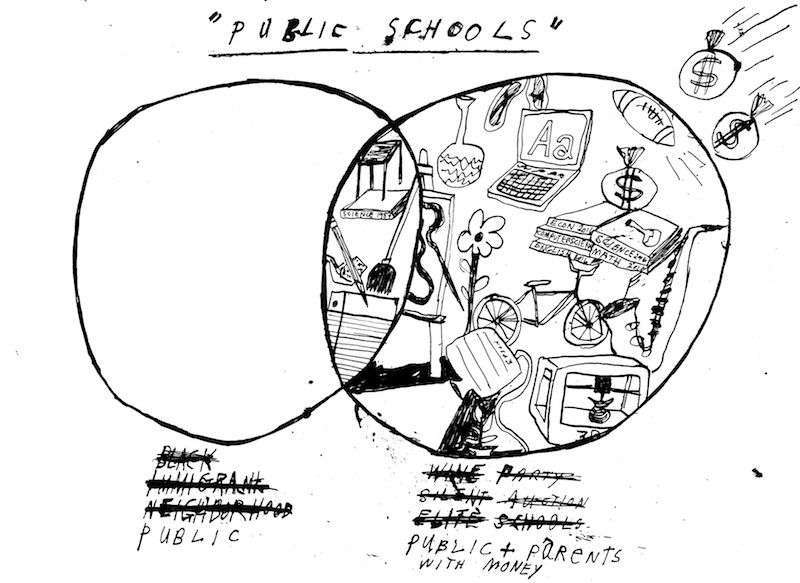My So-Called Public School
School foundations and the myth of funding equity
Illustrator: Colin Matthes

At 24, as a brand-new teacher looking for my first job, I went through the rigmarole of applications, interviews, and job fairs. My first offer came from Lake Oswego, a city I knew only by its reputation for affluence and racial homogeneity (whiteness). I had never visited, even though it was a mere 20-minute drive from Portland, Oregon, where I had lived most of my life. I took the job, a one-year, temporary position. I would be a “foundation teacher”: My salary was paid not out of the regular budget, but by the Lake Oswego Schools Foundation, a separate, private fundraising apparatus.
I would like to say that I was always enlightened enough to understand the implications of school foundations, but the truth is, at the time, I was just happy to have a job and didn’t pay much mind to where my paycheck was coming from.
Sixteen years later, I am still at Lake Oswego, no longer a foundation teacher, and now painfully aware of the insidious role school foundations play in perpetuating inequality in public education funding.
Anyone in education or interested in education policy has heard the claim “You can’t fix what’s wrong in education by throwing money at the problem.” Indeed, claims like this are made every legislative cycle as lawmakers wrangle over how much to budget for K-12 education and again during campaign season, when too many candidates jump on some version of the tax-cutting bandwagon.
But if more money is not a critical requirement for improving education, why have school foundations become so ubiquitous? According to Ashlyn Aiko Nelson and Beth Gazley, who published an investigation of these school funding nonprofits, school foundations have proliferated in the last decades, increasing threefold since the mid-1990s. So has the amount of money they are raising: School foundations and comparable organizations raised about $197 million in 1995; in 2010, the number had more than quadrupled to $880 million.
The Lake Oswego Schools Foundation raised roughly $1.5 million for the 2014-15 school year, with 31 families donating more than $5,000 apiece; almost 100 families donated more than $2,500 and triple that number donated at least $1,250. All said, the average family contribution was $650. These dollars matter in the halls of the schools in my district. Last year, $1.5 million meant 16 additional teachers, smaller class sizes, and additional elective offerings.
What is behind the increasing role of school foundations like the one in my district? In our state, like many others, foundations have been a way of addressing the budgetary limitations caused by the passage of property tax caps—here in Oregon, the property tax limitation, Measure 5, passed in 1990—and changes to education funding formulas. The property tax caps were the work of anti-tax activists; the changes to school funding were the work of those concerned about inequality. Together, these changes have given rise to a system that leaves most schools underfunded (as property tax caps limit revenue), with some schools, particularly in the rural parts of the state, faring better than before (because of the equalization funding formula). Wealthy districts, like mine, saw a net loss in funding with equalization.
In the old system, districts received roughly 60 percent of their funding from local property taxes; in the new system, almost all education taxes go into the general fund, to be allocated relatively equitably, on a per-pupil basis. For a wealthy city like Lake Oswego, property tax caps meant less revenue; and funding equalization meant a smaller piece of the pie.
What would have been an appropriate response to this admittedly unsatisfying outcome for my district? Perhaps a demand for an honest accounting of the real value and cost of high-quality public education? Perhaps a political mobilization around the benefits of a robustly funded public sector for all of Oregon’s residents?
But that is not what happened. Instead, many districts, including mine, found a work-around for both property tax caps and equalization, enabling them to pursue their own, independent streams of revenue. School foundations mean the wealthy can have their cake and eat it, too. They can vote for—or at least tolerate—lower statewide taxes (taxes that go into the general fund and are shared among students and families throughout the state) with confidence that their schools, their teachers, and their electives programs will stay intact.
There is a disturbing us vs. them narrative about education implied in the fundraising materials distributed by school foundations. Slick marketing campaigns promote a competitive discourse, suggesting that educational excellence is a scarce resource that must be fiercely defended with a steady flow of monetary contributions. For example, on the Lake Oswego Schools Foundation website—chock-full of glossy photos, videos, and infographics—visitors are met with the following headings:
In a Class of Our Own
Lake Oswego School District Ranked #1 in the Country
Our Amazing Test Scores
Help Us Keep Lake Oswego Schools on Top of the Curve
The not-so-subtle subtext: In a world where quality education is scarce, where citizens must battle each other for a piece of the educational pie, Lake Oswego is doing well but, without continued donations, slippage could occur. Today’s #1 could be tomorrow’s 2nd-rate district. Nowhere do we find advocacy or concern for all of Oregon’s children. Nowhere does the foundation suggest parents contact their legislators to demand more funding for all districts. This is about taking care of our own.
The rise of school foundations has occurred alongside a much larger and more insidious trend in education. A wealthy, donor elite—the Walton Family Foundation, the Bill & Melinda Gates Foundation, the Eli and Edythe Broad Foundation—use their influential dollars to push pet, and sometimes profitable, projects that dangerously deform public policy. From Common Core to charter schools and Teach For America, these donor-enabled initiatives have largely bypassed democratic processes, empowering the wealthiest Americans to make crucial decisions about curriculum, funding, teachers, and schools.
One danger of school foundations in wealthy cities and neighborhoods like Lake Oswego is that they, too, could exercise outsized influence over policy, shaping the choices of the school board through the seductive influence of scarce dollars. When vital school services—not just “enrichment” activities, but teachers and books—are paid for with foundation dollars, what school board could resist the will of the largest donors, who give in excess of $10,000 year after year?
I will allow that most of the donors to the Lake Oswego Schools Foundation have no interest in directing or influencing education policy, and simply want to do what they can to provide vital support to schools they value. But these private donations help perpetuate the idea that education funding is somehow optional, one more “charity” for rich people to altruistically fund, rather than a necessity in a democratic society—a public “must-fund” for all of America’s children.
In many ways, the foundation has made my school a wonderful place to work. During the recent recession, as some districts in my state reported ballooning class sizes (50 students in Algebra I!), ours grew, but not unbearably. While other districts laid off scores of teachers, painful cuts were made at my school, but they were in the single, not double, digits.
But school foundations that rely on the individual wealth of a district’s residents to provide basic components of a sound education make a mockery of the progressive premise of public education as a public good that should be provided to all. They turn education into just another commodity that can be hoarded by the wealthy to the detriment of everyone else. They dangerously misshape the already-problematic metrics of accountability—where test scores and graduation rates are compared across districts—by obscuring yet one more example of how our society asks poor children to do more with less.
REFERENCE
- Nelson, Ashlyn Aiko and Beth Gazley. February 2014. The Rise of School-Supporting Nonprofits. ssrn.com/abstract=2363032 or dx.doi.org/10.2139/ssrn.2363032.

